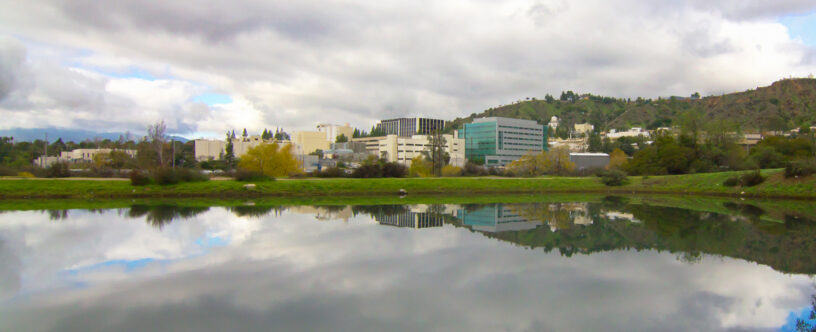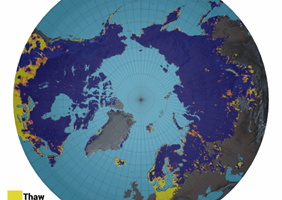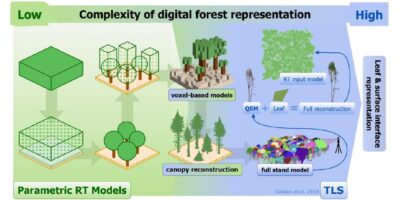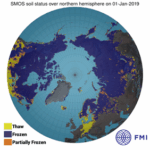Research scientist Otto Lamminpää’s recent doctoral dissertation research on atmospheric remote sensing of greenhouse gases led to a postdoctoral position at the NASA Jet Propulsion Laboratory. Read his interview here below:
In his dissertation, while still working at the Finnish Meteorological Institute (FMI), Otto Lamminpää developed and implemented rigorous, robust and computationally efficient means of uncertainty quantification for atmospheric remote sensing of greenhouse gases. He considered both CO2 measurements by NASA’s Orbiting Carbon Observatory 2 (OCO-2) and CH4 measurements by Sodankylä Arctic Space Center’s Fourier Transform Spectrometer (FTS).
Otto Lamminpää’s dissertation “Dimension reduction approaches for atmospheric remote sensing of greenhouse gases” was examined on June 25, 2020 at the Faculty of Science of the University of Helsinki. The opponent was Professor Patrick Eriksson from the Chalmers University of Technology, Sweden, and the custos was Professor Eero Saksman from the University of Helsinki, Finland.
JPL Postdoctoral Program
The Jet Propulsion Laboratory (JPL) managed by Caltech (California Institute of Technology) for NASA is a unique research facility for space and Earth science missions. Since the opening of the Space Age, JPL continues its world-leading innovation, implementing programs in planetary exploration, Earth science, space-based astronomy and technology development. The JPL Postdoctoral Program provides significant training for the future scientific and technological leaders and allows postdocs to work directly with a JPL advisor on a research topic of mutual interest.
* What kind of research topics are you working with in JPL? Is the work in some respects a continuation of your doctoral dissertation work?
“The umbrella term for my postdoctoral research project is Uncertainty Quantification for Carbon Flux Inversion. This is approached from OCO-2’s perspective. OCO-2 Carbon dioxide measurements, the L2 data of XCO2, is used as a constrain in the Carbon Flux inversion algorithms, and currently the accounting of uncertainty in these calculations is not well established. Data needs to be averaged somehow in order to be used at the resolution of the inversion grid, and the meaning of uncertainty in XCO2 and how to account for it is not well agreed on. This topic is enormously consequential, since an overly optimistic trust on the accuracy of assimilated data constrains the flux inversion too much, and putting in too much uncertainty can leave out useful information. In short, it’s important to know how well one can trust the input data. The first step of my work is implementing a statistical emulator for the OCO-2 Full Physics forward model. If done right, this allows fast approximate retrievals to be performed, and the uncertainty in measured radiances can be more easily propagated to retrieved XCO2 and tracked down to changes in retrieved fluxes. My dissertation work had to do with Markov Chain Monte Carlo methods for the OCO-2 retrieval, and this topic has spiked the interest of many potential collaborators here in JPL. I’m sure this line of work will be continued during my postdoc, especially if I can apply the fast OCO-2 emulator to MCMC as well!”
* How would it be possible to deepen the already well ongoing cooperation between JPL and FMI in the field of greenhouse gas monitoring using satellites? Further, what kind of scientific breakthrough could be striven for in the future under the cooperation?
“FMI-SPACE hosted a Workshop on Inverse Problems and Uncertainty Quantification in Satellite Remote Sensing in 10–12 October 2018, in which JPL participation was high along with other experts from places like MIT. This brought together an excellent collaborative of scientists with different expertise in mathematics, statistics, physical sciences and beyond. The meeting didn’t happen due to COVID-19 this year but upkeeping a (bi) yearly workshop like this definitely is a good way to deepen collaboration. Applying for project funding together and exchanging visitors between the two institutions is also a proven way to deepen the collaborations. Central scientific breakthroughs in this area at the moment would definitely include fast, operational MCMC for uncertainty quantification, and also getting a meaningful way to quantify uncertainty in different satellite-related machine learning applications. Both open questions would, when solved, improve our understanding and level of trust in any measured quantity. A growing amount of data and need for fast and efficient processing would also benefit from these results.”
* How does it feel to live in California specifically during the pandemic?
“I have had a quite unfortunate timing with my arrival. Naturally, the pandemic is raging all over the world and it is a norm to see a “No Mask, No Service” sign whenever you enter a store, pharmacy or a restaurant, and if someone is seen outside without a face cover it is sure to draw long and disapproving looks. California represents the part of US that does listen to scientists and takes the pandemic situation seriously, luckily. I have also experienced the largest forest fires locals have seen, and the sky has been covered in smoke for weeks at a time together with hazardous air quality warnings. Naturally I have stayed inside a lot and not seen many people face-to-face, even colleagues, so times surely are exceptional. We have also been feeling heat waves during which the temperature rises almost to 40C even now in October, which normally would last no longer than late September. This might just be a warmer than usual year, but one is tempted to wonder the role of climate change as well. Even with these wrinkles the overall experience has been very positive. I’m enjoying the continuous sunshine every day now, the food is great (especially locally grown fruits and vegetables), and the landscape with palm trees and iconic sunsets are a pleasure to see each day. I’ve met some amazing people and had the privilege to work in one of the most scientifically exciting environments in the world with a project that I feel is meaningful and challenging in just the right way.”
The research was carried out at the Jet Propulsion Laboratory, California Institute of Technology, under a contract with the National Aeronautics and Space Administration (80NM0018D0004).
More information:
Research Scientist Otto Lamminpää, otto.lamminpaa@fmi.fi, otto.m.lamminpaa@jpl.nasa.gov
Doctoral dissertation is available at: http://hdl.handle.net/10138/316689
JPL: https://postdocs.jpl.nasa.gov/ and https://www.jpl.nasa.gov/about/








Leave a Reply
You must be logged in to post a comment.